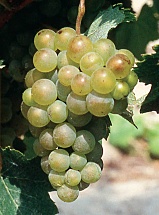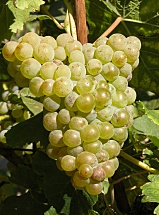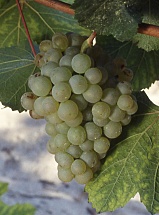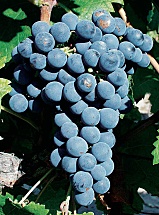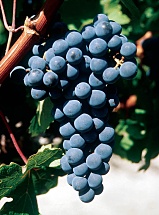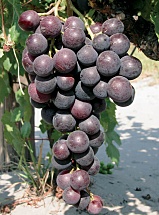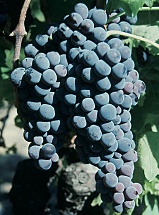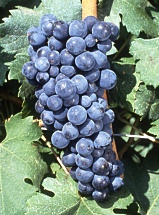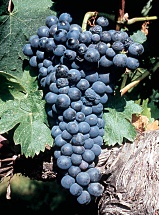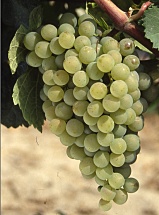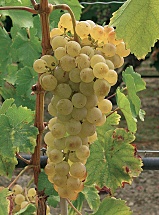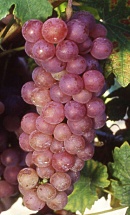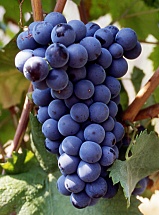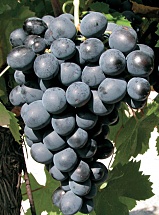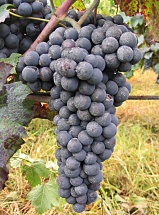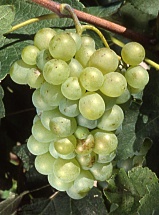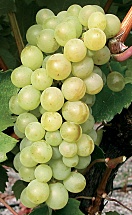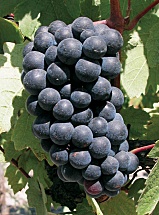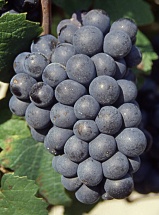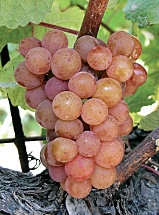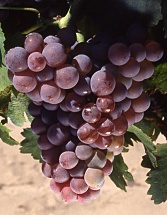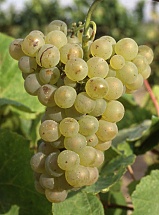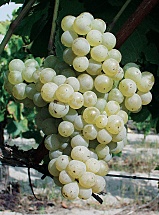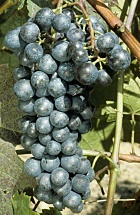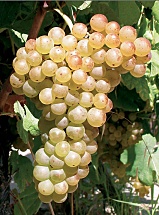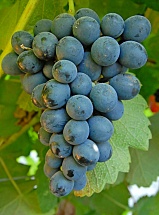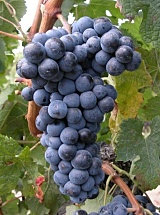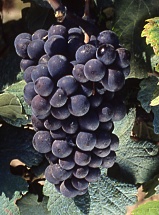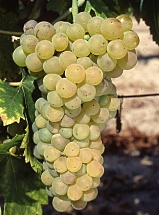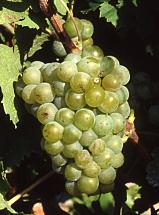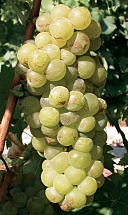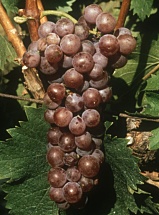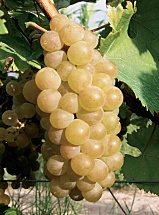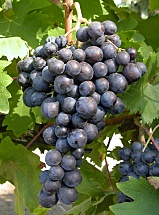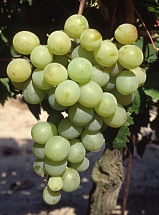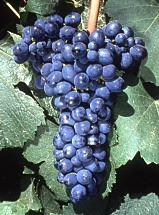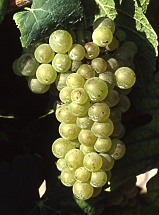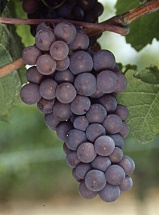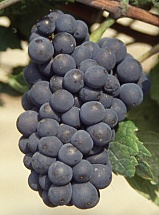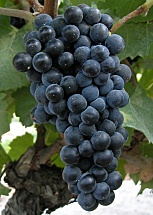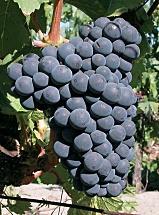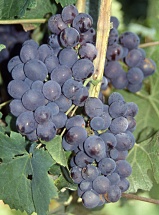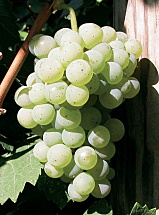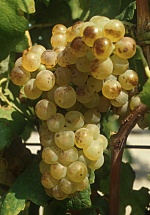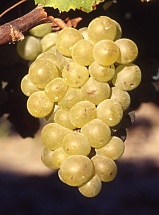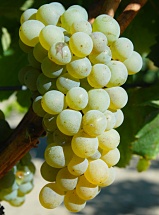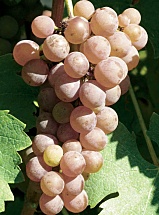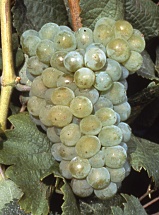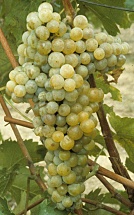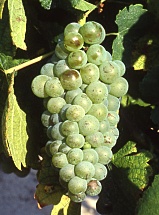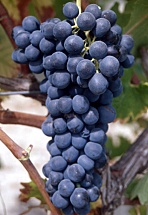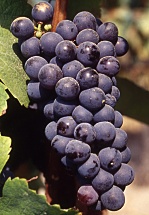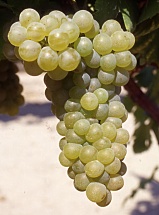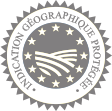Aligoté
Grape certainly from Bourgogne. Genetic analyzes have shown that it is the result of a cross between Gouais blanc and Pinot.
Aligoté is part of vine appellations Bourgogne -Aligoté, Bouzeron, Beaujolais-Villages, Bourgogne Grand ordinaire, Crémant de Bourgogne, Bugey, ...
It gives a lively nervous wine, more or less aromatic and has sometimes a particular character. Drink early in most cases.
Aromas of acacia, lemon, hazelnut, white peach, green apple, grape, vanilla, ...
 Link to the website
Link to the website
 Locate winemakers growing this variety on the map (3)
Locate winemakers growing this variety on the map (3)
Altesse
Savoie native variety but also grown in the Ain and Isère, Altesse grape is called Roussette as well. Ampelographic studies give it a cousinhood with Viognier, Marsanne, Roussanne, or Syrah and Mondeuse.
Altesse is part of vine appellations Bugey, Roussette de Savoie, Roussette du Bugey, Seyssel and Vin de Savoie. It is on the hillsides of Jongieux in Savoy, that gives it its name Marestel the most advanced aromatic expression.
Alone or combined with other grapes (Chardonnay, Mondeuse blanche), it provides two types of wine: either dry white, generous, full-bodied, aromatic, elegant and suited to aging, or soft white, sparkling or effervescent.
 Link to the website
Link to the website
 Locate winemakers growing this variety on the map (10)
Locate winemakers growing this variety on the map (10)
Arvine
It is very present in the Swiss Valais, as well as in the Aosta Valley in Italy. It is a noble grape that used to be grown in Savoy.
Not to be confused with the Sylvaner sometimes called Grande Arvine with no relationship. Based on genetic analyzes published in Switzerland, Arvine would be very close to Chasselas. It is also a related to Grosse Arvine, very few cultivated today.
Arvine gives an elegant wine, full-bodied, manly, very distinctive,, complex and in most cases very balanced, almost always with a saline final grade. Dry, it can be drunk rather young; sweet or liquorous, it has an aging potential of several years.
Aromas of citrus (lemon, grapefruit ...), pineapple, mushroom notes, quince, spices, passion fruit, yellow stone fruits, wisteria blossom, mango, honey, rhubarb, ...
 Link to the website
Link to the website
 Locate winemakers growing this variety on the map (3)
Locate winemakers growing this variety on the map (3)
Auxerrois
Lorraine grape, grown in Moselle before 1914, it has been multiplied after 1950 in the Alsatian vineyard by vineyard and oenological research station of Colmar - Upper Rhine. Based on genetic analyzes, it it comes from a cross between Gouais blanc and Pinot. It is part of vine appellations Alsace, Côtes de Toul, Moselle, ...
Auxerrois gives a rather fine wine, slightly aromatic, sometimes lacking acidity. It is often vinified with Pinot Blanc which brings a fruity character.
Aromas of quince, exotic fruits, spices, white flowers, honey, toasted notes, grapefruit, apple.
 Link to the website
Link to the website
This grape is not grown now
Cabernet franc
It is the oldest variety grown in Gironde (1st century AD).
It was probably chosen or selected empirically within plant material from the north side of the Pyrenees (Spanish Navarre and Gipuzkoa), area of the very ancient vineyards of Txakoli.
It should be noted that two other grapes are similar : Morenoa and Txakoli Noir; this last one shares with Cabernet Franc and Gros Cabernet the same synonymous (h)Ondarrabi beltza.
It is traditionnally part of vine appellations Médoc, Graves, Saint-Emilion, Bergerac, Pécharmant, Côtes de Duras, Buzet, Madiran, Irouléguy, Béarn, Côtes du Marmandais, Côtes du Brulhois, Bourgueil, Saint Nicolas de Bourgueil, Chinon, Saumur, Saumur-Champigny, Touraine, Coteaux du Loir, Anjou, Rosé de Loire, Rosé d'Anjou, Cabernet d'Anjou, Cabernet de Saumur, Orléans-Cléry, Cheverny, Coteaux du Vendômois, Coteaux d'Ancenis, Vins du Thouarsais, Haut Poitou, Malepère, Cabardès, Limoux ... and Vins de Pays.
It provides a quality wine, very structured, fragrant, less colorful than the one with Cabernet Sauvignon and less rich in tannins, allowing a faster aging.
Aromas of cocoa, blackcurrant (sometimes mixed with vegetal notes of blackberry wood), quince, spices, ivy leaf, fern, strawberry, raspberry, ripe fruit, menthol notes, dry pepper, green pepper, undergrowth, tobacco, violet.
 Link to the website
Link to the website
 Locate winemakers growing this variety on the map (1)
Locate winemakers growing this variety on the map (1)
Cabernet-Sauvignon
Grape widely grown in the Gironde where it would be native. It comes from a cross between Cabernet Franc and Sauvignon Blanc.
It is part of vine appellations Médoc, Graves, Saint-Emilion, Bergerac, Pécharmant, Côtes de Duras, Buzet, Cotes de Provence, Les Baux de Provence, Coteaux d'Aix-en-Provence, ...
Cabernet Sauvignon often brings an interesting tannic structure accompanied with a deep color, usually suited to aging and maturing in wood. Vinified alone, it sometimes lacks fat and roundness.
Aromas of ripe blackcurrant, blackcurrant leaf, dark chocolate, sweet spices, fern, smoke, cherry, blackberry, green pepper, plum, licorice, underbrush, tobacco, truffles, vanilla, violet.
 Link to the website
Link to the website
 Locate winemakers growing this variety on the map (1)
Locate winemakers growing this variety on the map (1)
Cardinal
It is a variety that has been obtained in 1939 in the USA (California) by Elmer Snyder and Frank Harmon. It was not until 1946 that it was introduced in France. After long thought that this variety was related to a mutation of Ahmeur bou a(h)meur (North African grape variety), recent genetic analyzes indicate that the Cardinal would rather come from the crossing between Reine de vignes and Alphonse Lavallée.
Cardinal is consumed as table grapes. With the Prima, it is one of the first black varieties entering the markets. It should be noted that its good storability and transportation.
 Link to the website
Link to the website
This grape is not grown now
Carignan
Grape of Spanish origin, specifically from the Aragon region.
Carignan is part of vine appellations Côtes du Rhône, Languedoc, Corbières, Minervois, Côtes du Roussillon, Côtes de Provence, Coteaux d'Aix-en-Provence, Les Baux de Provence,…
With big yields, carignan gives a low alcoholic wine without characters affirmed, often acid. When it comes from hillsides and produces little, it gives a well-colored wine, robust, powerful, generous, slightly astringent with a bit of bitterness and calling in all cases to age. If you are lucky enough to find a wine 100% carignan, you will take care to open the bottle an hour or two before serving, preferably at a temperature of 15 °, in order that it can release all its aromatic qualities.
Aromas of banana aromas, herbaceous notes and mineral.
 Link to the website
Link to the website
This grape is not grown now
Carmenère
Very formerly grown in the Bordeaux region where it originated (specifically Medoc), it would come from the intraspecific cross between the Gros Cabernet and Cabernet Franc, from genetic studies in Montpellier (Hérault).
Virtually unknown in other French wine regions with rare exceptions, today it is found in Bulgaria, Malta, Italy and Chile ... where it represents nearly 10% of cultivated black grapes.
It is part of vine appellations Bordeaux, Crémant de Bordeaux, Graves de Vayres, Haut Médoc, Margaux, Médoc, Moulis, Pauillac, Pessac-Léognan, Premières Côtes de Bordeaux, Saint-Emilion, Saint-Emilion Grand cru, Saint-Estèphe, Saint-Julien.
Carménère gives a very colorful wine with violet hues, rather rich, tannic with few bitterness, sometimes lacking acidity but often with great aromatic persistence. Young wines are characterized by herbaceous taste.
Aromas of beetroot, coffee, sweet spices, ripe strawberry, raspberry, blackberry, smoke, licorice, ...
 Link to the website
Link to the website
This grape is not grown now
César
This is a very old grape variety known mainly in the Yonne’s department. Its true region of origin is however not known even if its name reminds obviously the Roman era. Genetic analyzes confirm that it comes from a natural cross between Pinot Noir and Argant.
It is is part of vine appellations Bourgogne-Coulanges, Bourgogne-Chitry, Bourgogne-Epineuil, Bourgogne-Côtes d'Auxerre, Bourgogne mousseux, Coteaux bourguignons, Irancy,…
Caesar gives a hard wine, colorful, rich in tannins and suitable for aging with aromas of cherry, red fruit ...
 Link to the website
Link to the website
This grape is not grown now
Chardonnay
A strong presence in Champagne and Bourgogne, it is in Chablis the only cultivated variety. Different genetic analyzes have shown that it is the result of a cross between Gouais blanc and Pinot.
Chardonnay is part of vine appellations Champagne, Saumur, Orléans, Touraine, Vins du haut Poitou, Vins du Thouarsais, Bugey and Vin de Savoie.
It is also highly represented in so-called "new world" countries.
With reasonable yields, it gives a wine of great finesse, well-balanced, powerful, wide and with a strong aromatic potential. Chardonnay also lends itself well to breeding and fermentation in barrels.
In the South of France, it should be harvested early enough to get a high quality product and the balance degree / acidity should be especially monitored.
Chardonnay is a very revealing variety of the soil and climate suitable for both fresh and warm, it will develop very different flavors depending on where it is grown and how it is raised. The following list (not exhaustive ...) is a proof:
Aromas of acacia, almonds, toasted almonds, almond green, amber, hawthorn, banana, fresh butter, brioche, cinnamon, blackcurrant, cherry, mushroom, honeysuckle, wax, lemon, leather, quince, spices, blackcurrant leaf, flower orange, fresh hay, fern, dried fruit, fresh grass, lilac, lily, mango, candied chestnut, spearmint, bread, honey, mousseron, blackberry, hazelnut, toasted hazelnut, buttery notes, peach-stone, orange confit, white nettle, buttered bread, toast, grapefruit, papaya, almond paste, white peach, rose petal, flint, pear, pepper, apple, licorice, flint, undergrowth, elderberry, blond tobacco, lime, toast, truffle, vanilla, verbena, purple, ...
 Link to the website
Link to the website
 Locate winemakers growing this variety on the map (22)
Locate winemakers growing this variety on the map (22)
Chasan
It is a grape variety originating from an interspecific cross between listan and chardonnay obtained by Paul Truel in 1958.
It gives a fine wine, aromatic, pale yellow color, sometimes with high alcoholic degrees at the expense of acidity, and remains quite sensitive to oxidation.
Aromas of citrus, almonds, fresh butter, white flowers, dried fruit, fresh straw, apple, vanilla, ...
 Link to the website
Link to the website
This grape is not grown now
Chasselas
This is a very old grape variety, known worldwide both for the production of table grapes and winemaking.
Based on genetic analyzes conducted in Switzerland in 2009, it would be a native of Switzerland (Vaud specifically), but it seems that it would be difficult to identify its parents probably missing today. It is in this same Valais that it is known as the " fendant" because of its fragile grains that open to pressure. In France, it is the AOP Chasselas de Moissac which is its most famous declination. Chasselas offers many mutations, which are often natural, such as the Cioutat with marbled foliage and palmatisect leaves, the muscat white variety or the Chasselas rosé.
It is part of vine appellations Alsace, Crépy, Seyssel effervescent, Vin de Savoie, Marignan, Ripaille, Pouilly-sur-Loire,…
It gives a pleasant wine to be drunk young, generally low alcohol and low acid.
Aromas: hawthorn, ripe lemon, mint, hazelnut, ...
 Link to the website
Link to the website
 Locate winemakers growing this variety on the map (5)
Locate winemakers growing this variety on the map (5)
Chasselas Rosé
This variety is the rose mutation of the Chasselas blanc with the same general characteristics, and with a more developed production area (Alsace, large south-west, Provence, Corsica, ...).
 Link to the website
Link to the website
This grape is not grown now
Chatus
On the purely onomastic level, it should be noted that the town of Verclause (Drôme) has a hamlet named Chatus without being sure whether it is the origin. Before the phylloxera crisis, this variety was cultivated in general in the region of Aubenas (Ardèche) and in the north of the Drôme, in the south and east of the vineyards of the Hermitage. At the same time, it was also known in the northwest of the Isère (Canton Heyrieux), in Savoie and in the township of Givors (Rhône). In the Beauséjour region (Drôme), it was cultivated in a mix with well known varieties such as, among others, the Mondeuse noire and the Douce noir (corbeau).
The Chatus gives a rich colored wine, tannic, slightly acid, solid, hard, bitter, improving with age. It changes over time from a purplish color to a dark red, with a deep color and high shine. All its magnitude discovers between 5 and 10 years, the ideal being to open the bottle a minimum of five hours before drinking.
In Ardèche, it is associated to Syrah and produces excellent quality wines at good aging potential.
Aromas of coffee, cinnamon, plum brandy, dried figs, candied fruit, nearly ripe pomegranate, cherry, mulberry, medlar, quince paste, white pepper, plum, licorice, tobacco, vanilla, ...
 Link to the website
Link to the website
This grape is not grown now
Chenin
Certainly native of Anjou, Chenin is a grape variety that can also be encountered in South Africa, Australia, Argentina, Chile, the United States (California) or New Zealand.
Genetic analyzes have revealed that it is a parent with several grape varieties, such as Colombage.
In its quiet version, Chenin gives a very fruity wine with plenty of bouquet, elegant, always with good acidity, usually quite lively, nervous, which can be aged quite long.
It is generally used to produce sweet wines (see appellations Anjou, Bonnezeaux, Chinon, Coteaux d'Ancenis, Coteaux de l'Aubance, Coteaux de Saumur, Coteaux du Layon, Coteaux du Loir, Coteaux du Vendômois, Jasnières, Quarts de Chaume, Savennières, …), but also to produce many sparkling wines (see appellations Anjou, Crémant de Loire, Montlouis sur Loire, Saumur, Touraine, Vouvray,...).
Aromas of dried apricot, acacia, bitter almond, toasted almonds, pineapple, hawthorn, banana, bergamot, brioche, cocoa, chamomile, cinnamon, honeysuckle, lemon, quince, pear compote, quince jam or apricot, candied dates, citrus peel, spices, dried fig, cut hay, candied fruits, broom, wallflower, mango, mint, honey, mineral, muscat, hazelnuts, walnuts, quince grapefruit, white peach, white pear, apple, grape Corinth, licorice, rose, tea, lime, white truffle, verbena, ...
 Link to the website
Link to the website
This grape is not grown now
Cinsault
Southern grape which origin seems to be the Provence, it reached the Rhone Valley, Languedoc-Roussillon and even North Africa (Algeria). Genetic analyzes have revealed that it is parent with Rivairenc or Aspiran. In South Africa, it was crossed with the Pinot noir to give a very cultured hybrid: Pinotage.
It is part of vine appellations Châteauneuf du Pape, Côtes du Rhône, Côtes de Provence, Languedoc, …
It gives generally a low alcoholic wine, deficient in acidity and color, allowing blends to be drunk young. On hillsides, wines get a beautiful red color, soft, fruity, with a pleasant scent.
Aromas of almond, linden blossom, raspberry, hazelnut, ...
 Link to the website
Link to the website
This grape is not grown now
Clairette
It is a typical southern variety. It has long been cultivated in Adissan (Hérault), where it was used to produce the appellation Clairette d'Adissan, now known as Clairette du Languedoc. Clairette blanche is vinified alone for appellation Clairette du Languedoc, Clairette de Bellegarde and Coteaux de Die, and associated with Muscat with small white grains for the Clairette de Die.
It is also part of the vine appellations Châteauneuf du Pape, Côtes du Rhône, Côtes de Provence, Cassis, Bandol, Bellet, Coteaux d'Aix-en-Provence, Les Baux de Provence, Palette and Ventoux.
The Clairette grape produces a very alcoholic wine, fresh, usually with little bouquet and little acidity. It should be drunk within a year or it "maderizes" fairly quickly taking a yellow to brown yellow color, associated with some bitterness.
Aromas of apple, fennel, lime, ...
 Link to the website
Link to the website
This grape is not grown now
Clairette rose
It is a variety of Clairette, also called Blanquette rose. Very few cultivated in France (under 400 hectares), it has the same general characteristics as the Clairette.
 Link to the website
Link to the website
This grape is not grown now
Corbeau (Douce noire)
Before the phylloxera crisis, Douce noire one met in a region between Vallée de la Saône and Isere, on the banks of the Rhone river from the exit of Switzerland to the junction with the Isere. In Savoy, it represented a very important area and was very often associated with Persian and Mondeuse noire to minimize the acidity and relax their tannins. It could also be found in Côte d'or, Yonne, Charentes, Dordogne, Lot et Garonne. Today, it is almost no more multiplied even though it was listed since 2008 in the Official Catalogue of vine varieties under the name Corbeau. Douce noire has long been confused with Italian Dolcetto nero.
This variety gives a soft wine, lively, with harmonious tannins, slightly alcoholic, ideal to produce a young wine. Part of the grape varieties Vins des Allobroges.
Aromas of red berries, elderberries, violet, ...
 Link to the website
Link to the website
 Locate winemakers growing this variety on the map (3)
Locate winemakers growing this variety on the map (3)
Folle blanche
It was used in the production of Armagnac and Cognac, today somewhat leaving its place to the Ugni Blanc. Based on genetic analyzes, Folle Blanche would have as ascending the Gouais blanc.
Folle Blanche is part of the grape varieties of the appellation of Gros Plant du Pays Nantais.
It gives an acid wine, shiny, slightly alcoholic, neutral taste. The spirits of this variety are very thin, pleasant to smell and drink, often with a fragrance and exquisite bouquet.
 Link to the website
Link to the website
This grape is not grown now
Furmint
Very old variety, probably of Italian origin, imported in Hungary around 1250. It was introduced in France in the early 19th century. It remains highly confidential since the phylloxera invasion, and particularly in the departments of Herault, Aude and Gard.
In Hungary, it is used to produce the famous Tokay or Hegy-Allya in blends with Harslevelu grape. Furmint can alos be found in Slovakia, Romania, Moldova, Croatia, Slovenia, Macedonia, Austria, South Africa, Argentina, vinified both dry than liquorous. Based on genetic analysis, it is a likely descendant of Gouais blanc.
The Furmint grape variety is part of the Palette.
Aromas of metallic flavor, with notes of pear, lime zest. As aging, sometimes cinnamon, chocolate, spices, smoke, tobacco, tea, ... For sweet wines, soft or liquorous : apricot, marzipan, blood orange, candy.
 Link to the website
Link to the website
This grape is not grown now
Gamaret
Coming from the interspecific cross between Gamay and Reichensteiner obtained in 1970 by André Jacquinet from the Federal Agricultural Research Station Agroscope of Changins-Wadenswil (Switzerland).
From this same cross is born Garanoir grape.
Gamaret produces a wine with a beautiful dark ruby color, fine, structured and balanced with soft tannins, slightly spicy, rich in anthocyanins and other polyphenols, and suited to aging.
Aromas of cocoa, blackcurrant, spice, fig, raspberry, blackberry, ripe plum, licorice, violet.
 Link to the website
Link to the website
 Locate winemakers growing this variety on the map (4)
Locate winemakers growing this variety on the map (4)
Gamay
Typical Burgundian grape. Based on genetic analysis, it comes from a natural cross between Pinot and Gouais.
Gamay is part of the vine appellations Bourgogne, Bourgogne Passe-Tout-Grains, Crémant de Bourgogne, Mâcon, Mâcon supérieur, Beaujolais, Beaujolais supérieur, Beaujolais-Villages, crus du Beaujolais, Anjou, Touraine, Rosé de Loire, Coteaux du Loir, Coteaux du Giennois, Valençay, Châteaumeillant, Coteaux d'Ancenis, Vins du Thouarsais, Côtes d'Auvergne, Saint-Pourçain, Côtes du Forez, Côte Roannaise, Vins de Savoie, Châtillon en Diois, Bugey, Gaillac, Côtes du Marmandais, Lavilledieu, Estaing, Entraygues-Le Fel, Rosé des Riceys, Côtes de Toul, Luberon et de nombreux Vins de Pays.
It gives a wine with a beautiful vivid, intense, clear and bright red. It is clothed in purple, carmine, cherry, scarlet or all shades of ruby. It can also be garnet but never very dark. Often adorned with purple hues.
Aromas of ambergris, ripe banana, English candy, cocoa, cassis, ripe cherry, spice, strawberry, jammy strawberry, raspberry, currant, iris, jasmine, blueberry, blackberry, mineral notes, peppery notes, peony, apple, prune, mignonette, pink, faded rose, truffle, violet.
 Link to the website
Link to the website
 Locate winemakers growing this variety on the map (17)
Locate winemakers growing this variety on the map (17)
Gamay de Bouze
It is a mutation observed by Caumartin in 1823 on a strain of Gamay Noir with white juice. Like other Gamay teinturier, Gamay de Bouze served at a time to color the wine missing color.
It is part of the vine appellations Coteaux d'Ancenis et Touraine.
It gives a medium quality wine, lower than the one produced by the Gamay de Chaudenay and less colorful than the Gamay Fréaux.
 Link to the website
Link to the website
 Locate winemakers growing this variety on the map (1)
Locate winemakers growing this variety on the map (1)
Gamay de Chaudenay
It is a mutation observed by JM Bidault de Chaudenay - Saône et Loire - in 1832 on a Gamay de Bouze strain.
Like other Gamay teinturier, it also served at a time to color the wine missing color.
It is part of the vine appellations Coteaux d'Ancenis et Touraine.
It gives a less colored wine than the one produced by the Gamay Fréaux but with better qualities.
 Link to the website
Link to the website
 Locate winemakers growing this variety on the map (1)
Locate winemakers growing this variety on the map (1)
Gamay Fréaux
Mutation observed by Antoine Fréaux Couchey in 1841 in Couchey in Côte d'or on a Gamay de Bouze strain.
Like other Gamay teinturier, Gamay Fréaux served at a time to color the wine missing color.
It gives a little alcoholic wine, more colorful than Gamay Bouze and Gamay de Chaudenay, acid, tannic, very average quality.
 Link to the website
Link to the website
This grape is not grown now
Gewurztraminer
It is a pink and aromatic mutation of Savagnin blanc.
Gewurztraminer, well known in Alsace and Moselle, is cultivated in many other countries.
It is part of the vine appellations Vins d'Alsace. Vinified alone, it is sold under its name. Used for the production of sweet wines with powerful scent, very typical, dry (but the selection of noble grains or late harvest keeps residual sugar), often with a medium acidity and can be stored for several years.
Aromas of apricot, cinnamon, caramel, leather, spices, candied fruits, exotic fruits, passion fruit, dried fruit, gardena, juniper, geranium, lychee, mango, honey, roasted notes, gingerbread, grapefruit, pastry , citrus skin, yellow peach, peony, pepper, praline, licorice, pink, ...
 Link to the website
Link to the website
This grape is not grown now
Grenache
Grape certainly of Spanish origin.
In favorable situation - dry and stony soil - the resulting wine is full-bodied, heady, of a beautiful golden brown red color. The wine from pure Grenache noir ages quickly, its color oxidizes and tends to Rancio. In order to get good long keeping wines, it must be assembled with other grape varieties.
Grenache is part of the vine appellations Châteauneuf du Pape, Côtes du Rhône, Tavel, Côtes de Provence, Languedoc, Banyuls, Maury, Rivesaltes, Grand Roussillon, Rasteau,...
Aromas of banana - noticed with a wine from carbonic maceration - , burned, cocoa, coffee, cassis, spice, ripe fig, hay, raspberry, ripe stone fruit (cherry, prune ...), cooked fruit, dried fruit , smoke, tar, pepper, rancio, black licorice, burnt sugar, old wood, ...
 Link to the website
Link to the website
This grape is not grown now
Grenache blanc
It is a variety of Grenache, like the Grenache gris.
It is part of the vine appellations Châteauneuf du Pape, Côtes du Rhône, Tavel, Côtes de Provence, Languedoc, Banyuls, Maury, Rivesaltes, Grand Roussillon, Rasteau,...
Aromas of narcissus, privet flower.
 Link to the website
Link to the website
This grape is not grown now
Grenache gris
It is a variety of Grenache, such as Grenache blanc.
Grown mainly in the Eastern Pyrenees and Aude, it is part of the vine appellations coteaux varois en Provence, Rasteau, Banyuls, Collioure, Maury et Rivesaltes. It also enters in the composition of vins gris de Listel.
When it comes from old vines, it demonstrated a great minerality, with aromas of bitter almond, burnt caramel, fennel and dried apricots.
 Link to the website
Link to the website
This grape is not grown now
Gringet
It is an ancient vine, native to the Arve Valley in Haute-Savoie. It can evoke Savagnin or Traminer without having kinship ties.
The Gringet is part of the vine appellations Vin de Savoie (raw) and Vin de Savoie-Ayze.
It gives a light and lively wine and is most often used in the production of sparkling wine or semi-sparkling wines.
Aromas of spice, wisteria, floral notes.
 Link to the website
Link to the website
This grape is not grown now
Jacquère
Grape certainly originally from Savoy and Gouais blanc descending. It is particularly fond of the clay-limestone land with rocky scree.
It is part of the vine appellations Vins de Savoie and Bugey. Jacquère produces a pale wine, light - discreetly floral - bright, acid but with a pleasant freshness, often beading and intended to be consumed young.
 Link to the website
Link to the website
 Locate winemakers growing this variety on the map (20)
Locate winemakers growing this variety on the map (20)
Landal
It is derived from the interspecific cross between the 5455 Seibel and 8216 Seibel obtained by Pierre Landot in the early 20th century.
This hybrid grape has been very little cultivated in France. In the USA, it was used to produce white wines.
The Landal gives a wine of beautiful color, alcoholic, with strawberry flavor.
 Link to the website
Link to the website
This grape is not grown now
Marsanne
Marsanne is a native of the Montelimar area in the department of Drôme. For a long time, it is also found in the Saint-Péray area in Ardèche and Tain l'Hermitage in Drome.
It is in most cases associated with Roussanne. Vinified alone, its wine is lighter than the latter, low acidity with less bouquet and delicacy, and with a capricious and disappointing aging. Its aromatic potential is nevertheless superior to the Grenache blanc but too weak to type an assembly. Instead, it gives excellent sparkling wines such as the best known Saint-Péray.
It is part of the vine appellations Saint-Péray, Hermitage, Crozes-Hermitage, Saint-Joseph, Côtes du Rhône, Corbières, Cassis,...
Aromas of dried apricot, acacia, beeswax, honeysuckle, quince, spices, dried fruits (almonds, hazelnuts and walnuts), jasmine, fresh lychees, acacia honey, citrus notes, white peach, Berries wood, baked apple, licorice, truffles, ...
 Link to the website
Link to the website
 Locate winemakers growing this variety on the map (1)
Locate winemakers growing this variety on the map (1)
Mècle
This grape variety was very present once in Isère (Bourgoin region), it is now the subject of a confidential culture.
The mècle gives a solid wine, rich in color and tannins, a bit "stiff" at first, but with a lot of fullness.
 Link to the website
Link to the website
 Locate winemakers growing this variety on the map (1)
Locate winemakers growing this variety on the map (1)
Melon
It is an old Burgundian grape. Based on genetic analysis, it comes from a natural cross between Pinot and Gouais. It is also called Muscadet.
It is part of the vine appellations Muscadet, Muscadet-Sèvre et Maine, Muscadet-Coteaux de la Loire, Muscadet-Côtes de Grandlieu and also the wines of Bourgogne ordinaire et Bourgogne Grand ordinaire.
It gives a balanced white wine, fresh, light, pleasant, more or less acidic with discrete flavor, often drunk en primeur or lees. In the latter case, it must remain all winter on its lees until bottling before February 15 following the harvest, ensuring the wine a very pale color and a very popular bouquet and flexibily.
Aromas of green almond, lemon, lemon, quince, spices, iodine, blackberry, anise, honeyed notes, musk, grapefruit, peony, young golden apple, greengage, ...
 Link to the website
Link to the website
This grape is not grown now
Merlot
Grape originally from the Bordeaux region, it is derived from a cross between Magdeleine noire des Charentes and Cabernet Franc. It is also the half-brother of Côt (or Malbec) but not the black shape of Merlot blanc.
It is part of the red vine appellations of most Vins de Bordeaux, Bergerac, Pécharmant, Côtes de Duras, Buzet, Côtes du Marmandais, Brulhois, Malepère, Cahors, Pineau des Charentes, ... and many Vins de Pays from the South of France.
Its blend with Cabernet franc’s grape must provides more lightness, delicacy and soft and puts it into aquiring faster the properties that must be its share. Merlot noir has a color intensity of two times that Cinsault. Sensitive to oxidation, it must avoid repeated contact with air: it is to be consumed quickly.
Aromas of cherry, leather, spices, jammy strawberry, blackberry, animal notes (venison), plum, apple notes, prunes, liquorice, undergrowth, truffles, violets, ...
 Link to the website
Link to the website
 Locate winemakers growing this variety on the map (2)
Locate winemakers growing this variety on the map (2)
Meunier
Grape very present in the Champagne vineyards, it comes from a cottony mutation of Pinot Noir.
It is part of the vine appellations Champagne, Moselle, Côtes de Toul, Touraine, Touraine-Noble Joué and Orléans. It gives a soft wine, sometimes lacking in color, less refined and less alcoholic than Pinot noir, sensitive to oxidation - which is also the case for the grape must - moderately acid and rapidly evolving.
Aromas of banana, raspberry, apple pippin.
 Link to the website
Link to the website
This grape is not grown now
Molette
Native variety of Savoy, it would be coming from a natural intraspecific cross between Gouais and Gringet. It should not be confused with the Jacquère which also carries the synonym of " Molette de Montmélian ".
It is part of the vine appellations Vins de Savoie, Seyssel et Bugey. Vinified alone, it provides a common wine, slightly aromatic, light, rich in alcohol, often with good acidity, and herbaceous taste. It is most often associated with Altesse to produce the sparkling Seyssel.
 Link to the website
Link to the website
 Locate winemakers growing this variety on the map (3)
Locate winemakers growing this variety on the map (3)
Mondeuse
Cultivated for a long time in Savoie, this is not the black shape of the Mondeuse blanche. Studies show that it comes from a natural intraspecific cross between Mondeuse blanche and Tressot. Recent genetic research have several hypotheses, all of which confirm its close kinship link with Syrah (mondeuse noire is sometimes called " Grosse syrah ").
It is part of the vine appellations Vins de Savoie and Bugey. Gives a solid wine, tannic, colorful, with chewy, very distinctive, aromatic, moderately rich in alcohol, usually with good acidity, bitter at first and suited to aging.
Aromas of cassis, black cherry, spice, fig, strawberry, raspberry, cherry, iris, pepper, plum, black plum, truffle, violet, ...
 Link to the website
Link to the website
 Locate winemakers growing this variety on the map (15)
Locate winemakers growing this variety on the map (15)
Mondeuse blanche
Cultivated for a long time in Savoy, it is not the white form of the Mondeuse noire. It is the mother of Syrah, the father being the Dureza.
It is part of the vine appellations Vin de Savoie and Bugey.
The white mondeuse gives a wine of quality, long-life, rich enough in alcohol and often with good acidity.
 Link to the website
Link to the website
 Locate winemakers growing this variety on the map (3)
Locate winemakers growing this variety on the map (3)
Müller-Thurgau
Grape from a cross obtained in Switzerland in 1882 by Professor Hermann Müller-Thurgau (1850-1927). In 1998, a team of Austrian researchers has discovered by conducting molecular genetic analyzes, that the original cross is not Riesling x Sylvaner as traditionally accepted but Riesling x Madeleine royale.
Its short phenological cycle makes it particularly suited to northern areas. Müller-Thurgau is grown on over 41,000 hectares worldwide, and it is in Germany where it is most prevalent. In Switzerland, there is the main white grape and it is part of the vine appellation Moselle.
Müller-Thurgau gives an aromatic wine, quite rich in alcohol, with low acidity, often heavy, sometimes lacking finesse with a particular scent recalling some Muscat. Drink young. In Switzerland, where it is very popular, it makes grape juice.
 Link to the website
Link to the website
This grape is not grown now
Muscat à petits grains
Most likely of Greek origin, this grape has been cultivated since ancient times and is known worldwide.
Grown in many wine regions of southern France, it is part of the production of many natural sweet wines such as Muscat de Frontignan, de Lunel, d'Alsace, de Rivesaltes, de Mireval, de Beaumes-de-Venise, de Saint-Jean de Minervois; but also Banyuls, Grand Roussillon, Maury and Rivesaltes. In association with the Clairette, it produces Clairette de Die (Drôme).
Aromas of beeswax, lemon flowers, honey, pink, lime.
 Link to the website
Link to the website
 Locate winemakers growing this variety on the map (1)
Locate winemakers growing this variety on the map (1)
Muscat à petits grains Rosé
It is the pink mutation of muscat with small white grains from which it has the same general characteristics.
In France, it is only allowed in the departments of Bas-Rhin and Haut-Rhin.
 Link to the website
Link to the website
This grape is not grown now
Muscat à petits grains Rouge
This is a rare variety, from a variation of muscat with small white grains.
Giving a lot of juice, always with a good balance acidity / sugar, it is vinified in sweet and also dry.
 Link to the website
Link to the website
This grape is not grown now
Muscat Cendré
It comes from a cross between Pinot Gris and Muscat Ottonel obtained by André Bronner in 1973.
Muscat cendré gives a powerful, full-bodied and slightly aromatic.
 Link to the website
Link to the website
This grape is not grown now
Muscat de Hambourg
The cultivation of this variety is very old. According to recent genetic analysis, Muscat de Hamburg is from the cross between Muscat d’Alexandrie and Frankenthal.
It handles moderately well transportation but has good storability aptitudes.
It is found in the markets under the AOC Muscat du Ventoux.
 Link to the website
Link to the website
This grape is not grown now
Muscat d’Alexandrie
It would be an interspecific cross between Muscat with small white grains and Heptakilo.
It is part the vine appellations Banyuls, Banyuls Grand Cru, Grand Roussillon, Maury, Muscat de Rivesaltes, Rivesaltes and gives natural sweet wines with powerful aromas, elegant and floral.
It is also an excellent table grapes. In Spain (Andalusia), it is prepared as raisined grape and is named in Malaga “Moscatel Gorron”.
Aromas of citrus, floral, dried figs, fresh and exotic fruit, dried fruit, honey, candied orange.
 Link to the website
Link to the website
This grape is not grown now
Persan
Its exact origin is not wellknown, but its starting point would seem to be Saint-Jean de Maurienne in Savoie. It was long the dominant grape in the whole valley of the Arc to its junction with the Isere and even to the limits of the department of Drôme.
It can still be found in the Valley of Grésivaudan until Savoie. This variety is very similar to Etraire de la Dui.
The Persan is part of the vine appellations Vins de Savoie and Vins de Pays in the same region.
It provides a quality wine, bouquet, tannic, colorful, rich in alcohol, slightly hard when young but very capable of aging (from 12 to 15 years to reach its fullness).
Aromas of raspberry, violet, ...
 Link to the website
Link to the website
 Locate winemakers growing this variety on the map (9)
Locate winemakers growing this variety on the map (9)
Pinot Blanc
This is a mutation of Pinot Noir. A second Pinot blanc, which come from the Pinot gris, was selected by Christian Oberlin and multiplied mainly in Alsace.
Pinot Blanc is part of the grape varieties of Alsace and Champagne designations.
It gives a pleasant wine, slightly full-bodied, usually with medium acidity.
 Link to the website
Link to the website
This grape is not grown now
Pinot gris
Grape probably from Burgundy. This is the gray shape of pinot noir; it should be noted that its gray character is not related to its entire genetic code, but only to that of its mutated cell tissue on the periphery of the grapes and thus only the vegetative propagation can propagate this gray character.
Pinot Gris is grown mainly in the Pays de Loire and Alsace where it gives high quality wines, very fine, particularly those from late harvest or selection of noble grapes: Pinot Gris is well suited to an overmaturation of the grapes on strains.
Aromas of apricot, amber, fresh butter, smoked wood, cocoa, cinnamon, ash, mushroom, chanterelles, honeysuckle, beeswax, wheat, white fruit, passion fruit, broom, humus, fresh nutty, honeyed notes, wet straw, grapefruit, burning vines shoots, undergrowth, vanilla, ...
 Link to the website
Link to the website
 Locate winemakers growing this variety on the map (9)
Locate winemakers growing this variety on the map (9)
Pinot noir
Grape probably from Burgundy. Recently, Italian and Swiss researchers hypothesize that Pinot Noir is a great-grandparent of Syrah.
Pinot Noir makes many Burgundy, Champagne or Orléanais appellations famous. It produces a beautiful colored wine, with a pleasant bouquet, which remains long in the mouth and sometimes can be stored for a very long time depending on vintages.
Aromas of hawthorn, banana, heather, cocoa, coffee, cinnamon, black currant, mushroom, cherry, mushroom, chocolate, quince, fresh bread crust, leather, dates, spices, figs, fern, strawberry, jammy strawberry, raspberry, fruit confit, cooked fruit, ripe fruit, clove, cherry, currant, humus, jasmine, mint, blueberry, moss, blackberry, musk, animal notes, cherry stone, carnation, gingerbread, baked peach, pistachio, peony, pepper , pepper, plum, ripe plum, pepper, prunes, ripe grapes, liquorice, mignonette, pine resin, brier rose, faded rose, undergrowth, elderberry, wet earth, truffles, vanilla, venison, violet, ...
 Link to the website
Link to the website
 Locate winemakers growing this variety on the map (14)
Locate winemakers growing this variety on the map (14)
Plantet
The origin of Plantet is imprecise but it is certainly parent to Berlandieri or Jacquez. This vine was before 1960 the second direct hybrid producer the most cultivated after the 7053 Seibel (or Chancellor).
The Plantet gives a low quality wine, rich in color and alcohol, with in most cases a good acidity, with rather discreet tannins but with a rather unpleasant foxy flavor for those who do not have the habit of drinking this type of wine. This taste fades when the grapes are very ripe.
 Link to the website
Link to the website
 Locate winemakers growing this variety on the map (1)
Locate winemakers growing this variety on the map (1)
Portan
Grape resulting from a cross between Grenache Noir and Portugais bleu obtained in 1958.
Because of its early maturity, Portan helps develop young wines. Drink quickly.
It gives a fruity, slightly tannic, colorful and slightly alcoholic.
 Link to the website
Link to the website
This grape is not grown now
Poulsard
It is an old variety from Franche-Comté, mostly grown in the Jura. Genetic analyzes have revealed that it is parent with Rèze.
Poulsard is part of the vine appellations Arbois Arbois, L'Etoile, Côtes du Jura and Bugey. It gives a slightly colored wine of great finesse, taking a beautiful "onion skin" color with age, having the fire and a delicate fragrance. It is also an excellent table grapes with good-keeping qualitites.
Aromas of red berries (redcurrant, strawberry or raspberry), undergrowth, sometimes tawny impressions of meat, smoke, mineral notes, ...
 Link to the website
Link to the website
This grape is not grown now
Riesling
Very old variety, probably originated on the banks of the Rhin, it would also be a descendant of Gouais.
It is a great noble grape of Alsace. Vinified alone, it is part of the vine appellations Alsace, Vins d'Alsace, Alsace Grand Cru.
Riesling gives a high quality dry white wine, very aromatic, very characteristic bouquet that develops intensely depending on soil from which it comes, elegant with good-keeping qualitites. It also produces excellent liquorous wines from late harvest or selection of nobles grains.
Aromas of apricot, lemon, candied lemon, honeysuckle, lemon, spices, candied fruit, passion fruit, broom, mint, musk, animal notes where the wine is aged, mineral notes, yellow peach, grapefruit, apple, buttons pink, lime, ...
 Link to the website
Link to the website
This grape is not grown now
Roussanne
As Marsanne, Roussanne is a native of the Montelimar area in the department of Drôme. It is also found for a long time in the region of Tain l'Hermitage (Drôme) and Saint-Péray (Ardèche). Not to be confused with Var rosé or Var Roussanne, with rose colored berries and is almost no longer multiplied. In Savoy, it takes the name of Bergeron (Chignin).
Roussanne is a noble grape producing wines of high quality, fine, straw-colored, powerful, often with good acidity, a remarkable bouquet and aging very well.
It is part of the vine appellations Hermitage, Vins de Savoie, Crozes-Hermitage, Saint-Péray, Saint-Joseph, Côtes du Rhône, Châteauneuf du Pape, Corbières,...
In combination with other white varieties, Roussanne gives an aromatic supplement and elegance that the latter would not have without it.
Aromas of apricot, hawthorn, green coffee, honeysuckle, honey, discreet narcissus, iris root, ...
 Link to the website
Link to the website
 Locate winemakers growing this variety on the map (6)
Locate winemakers growing this variety on the map (6)
Roussette d'Ayze
Particular grape frome the Haute-Savoie vineyards, grown in the Arve Valley.
La roussette d'Ayze is part of the vine appellation Vin de Savoie-Ayze.
It provides an average quality wine, slightly aromatic and is mainly used for the preparation of sparkling wines.
 Link to the website
Link to the website
This grape is not grown now
Sauvignon
It is a typical grape of Bordeaux.
It is part of the vine appellations Sauternes, Barsac, Loupiac, Sainte-Croix du Mont, Bergerac, Monbazillac, Pouilly fumé, Blanc fumé de Pouilly, Sancerre, Menetou-Salon, Quincy, Reuilly, Valençay, Vin du Haut-Poitou, Saint-Bris, Cassis, Bandol,...
In Sauternes, it produces excellent sweet white wines. In other regions, it gives a dry white wine, very fragrant, elegant, fine, balanced, distinctive, and high in alcohol.
Aromas of apricot, acacia, bitter almond, pineapple, rosewood, blackcurrant bud, boxwood, blackcurrant, mushroom, lemon, quince, leather, spices, fennel, blackcurrant leaf, mackerel currant leaf, acacia flower, orange blossom, cut hay, fern, passion fruit, exotic fruits, broom, iris, mango, mint, honey, narcissus, smoky notes, musky notes, orange, straw, grapefruit, flint (Sancerre ), cooked leek, green pepper, fresh apple, flint, undergrowth, violet, citrus zest, ...
 Link to the website
Link to the website
 Locate winemakers growing this variety on the map (1)
Locate winemakers growing this variety on the map (1)
Sauvignon gris
It is a pink grain variation of Sauvignon Blanc which has the same characteristics.
Despite its name, it comes rather in a pale yellow dress, with a great aromatic complexity.
Aromas of grapefruit, boxwood, toasted bred, smoke, passion fruit, lychee, orange and menthol.
 Link to the website
Link to the website
This grape is not grown now
Savagnin Blanc
It is a grape that is native of Italy, specifically in the Tyrol. Genetic analyzes have revealed that it is a parent with several grape varieties including Petit Manseng. The Gewurtztraminer is an aromatic natural rose mutation of the Savagnin blanc.
It is part of all the vine appellations of Jura with the famous production of vin jaune. The wine Alsace-Klevener de Heiligenstein is also obtained with the Savagnin. It gives great vin de garde, powerful, heady, full-bodied and in many cases with good acidity.
Aromas of almond, cocoa, spices, floral, acacia honey, plum, muscat, hazelnut, walnut, green walnut, white pepper, green apple, ...
 Link to the website
Link to the website
 Locate winemakers growing this variety on the map (1)
Locate winemakers growing this variety on the map (1)
Seyval
Interspecific cross between the 5656 Seibel and the 4986 Seibel (or rayon d'or) obtained by the Villard Seyve’s House formerly based in Saint-Vallier (Drôme).
It can be found in the USA, Canada, Brazil, England, the Netherlands, Romania and Switzerland.
The Seyval gives a dry white wine with sometimes an ethereal odor, lively, slightly fruity with a nice freshness. Oxidizes very quickly so to be drunk fast. In England, it is used to produce sparkling wines.
Aromas of citrus, hay, fresh grass, kiwi, melon.
 Link to the website
Link to the website
This grape is not grown now
Sylvaner
It is from Austria and is part the vine appellations Alsace.
Vinified alone, Sylvaner is sold under its name. It usually gives a slightly acidic and neutral wine.
Aromas of acacia, mineral and vegetable.
 Link to the website
Link to the website
This grape is not grown now
Syrah
It is originated from Rhodanian. Through DNA analysis, a Californian team of researchers and the ENSA-INRA of Montpellier have discovered it is related to Mondeuse blanche (mother) and Dureza (father). Syrah is the aunt or uncle of Teroldego.
It is part of vine appellations Côtes du Rhône, Côte Rôtie, Cornas, Saint-Joseph, Hermitage, Châteauneuf du Pape, Palette, Côtes de Provence, Coteaux d'Aix-en-Provence, Les Baux de Provence, Languedoc, Corbières, Collioure, Côtes du Roussillon, Costières de Nîmes, Banyuls, Maury, Rivesaltes, Gaillac, Fronton,...
It provides high-quality wines, high in alcohol, intense color, very aromatic, fine and complex, tannic, structured and relatively low acids, suitable for aging. This variety allows to elaborate fruity rosés very pleasant to drink.
Aromas of banana, cocoa, cinnamon, black currant, cherry, bitter chocolate, leather, spices (peppery), raspberry, ripe raspberry evolving with time towards notes of pepper, wild raspberry, cooked fruit (prune), blackberry, animal notes (leather and skin), olive, licorice, underbrush, blond tobacco, truffles, violets, ...
 Link to the website
Link to the website
 Locate winemakers growing this variety on the map (3)
Locate winemakers growing this variety on the map (3)
Trousseau
It is a grape grown for a long time in the vineyards of the district of Poligny in the Jura and Doubs around Besancon. Based on genetic analyzes in Montpellier (Hérault), it is probably a descendant of Savagnin blanc.
It is part of vine appellations Arbois, Arbois-Pupillin, Côtes du Jura, Crémant du Jura and Macvin du Jura.
It gives wines of a beautiful deep purple color, typed, warm, full-bodied, structured and well aging, with the presence of anthocyanins diglucosides. Trousseau wine deserves to be assembled with Poulsard, the latter bringing finesse while the first improves conservation.
Aromas of spice, pepper, green pepper.
 Link to the website
Link to the website
This grape is not grown now
Velteliner rouge précoce
Grape probably originated in northern Italy. It occurs mainly in Austria, Germany, Switzerland, Hungary, Slovakia, ... but also somewhat in France where it is part of vine appellations Vin de Savoie.
It gives a wine with a particular bouquet, generous, bold, pleasant, rich in alcohol, slightly aromatic with a tendency to maderize quickly, usually with medium acidity.
 Link to the website
Link to the website
 Locate winemakers growing this variety on the map (1)
Locate winemakers growing this variety on the map (1)
Viognier
It is an ancient grape vineyards of Condrieu and Ampuis. It is also found in many South of France Vins de Pays where it is vinified alone in most cases.
Viognier is is part of vine appellations Condrieu, Château Grillet - vinifié seul -, Côte rôtie, Côtes du Rhône,...
It produces high quality wines, fat, soft to the limit of smoothness, very fine, very fragrant, sometimes lacking a good acidity and may sometimes have a slight bitterness. Serve cool but not chilled, as an aperitif or to accompany fish, crayfish, quenelles Lyonnaise or white meat.
Viognier can also be used to develop semi-sparkling or sparkling wines.
Aromas of apricot, oak, honeysuckle, wax, lime, quince, spices, almond blossom, flower hawthorn, dried fruit, toasted, iris, mango, acacia honey with which aging brings a touch of musk , mineral, gingerbread, fish, tobacco, lime, violet, ...
 Link to the website
Link to the website
 Locate winemakers growing this variety on the map (8)
Locate winemakers growing this variety on the map (8)
 Back to the top
Back to the top





